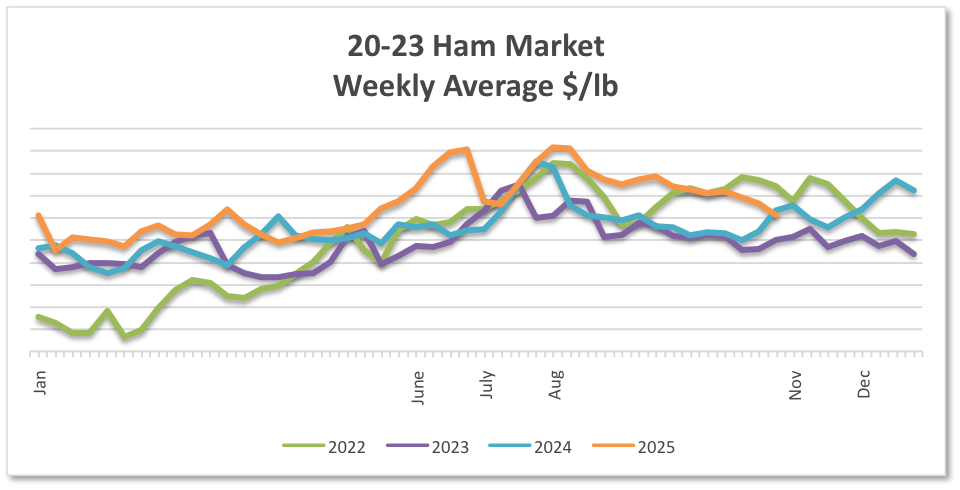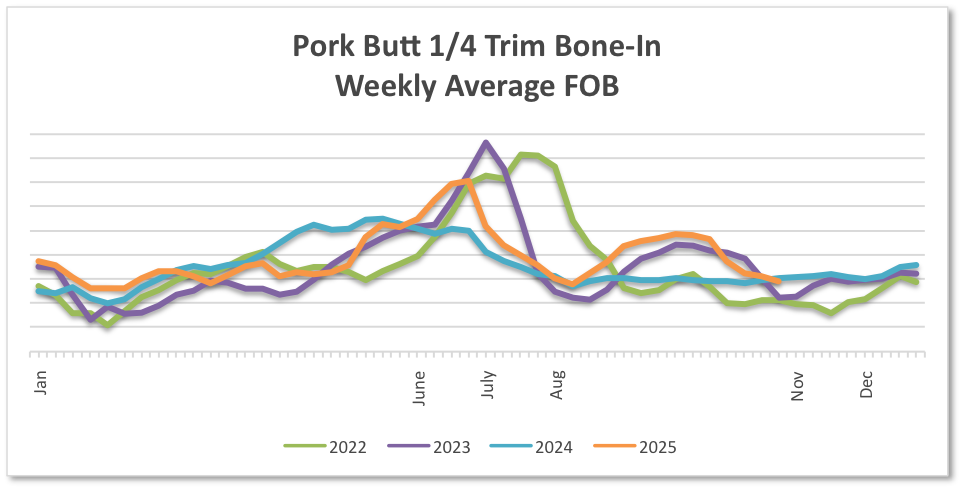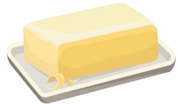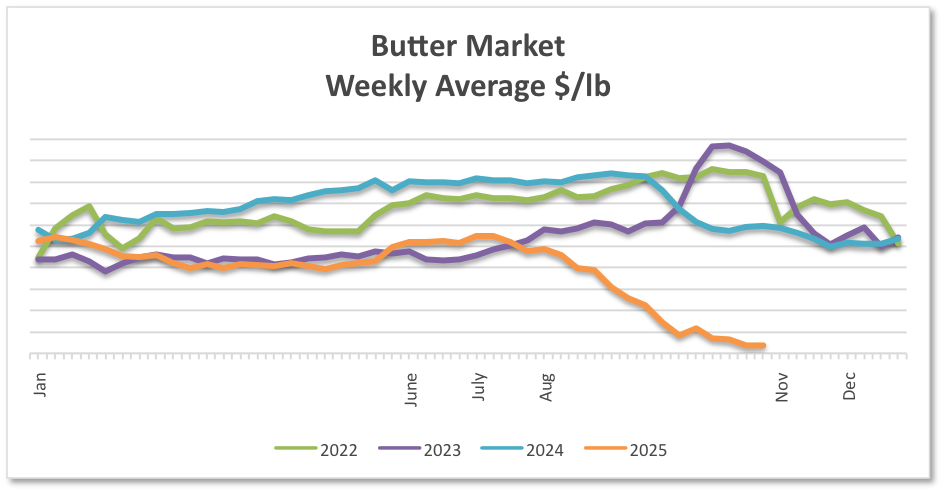Week Ending December 5, 2025
BEEF The market is steady to weaker. Total beef production for last week was down 14.2% versus the prior week and down 3.7% compared to the same week last year. Year to date, total production is down 4.4% compared to the same period last year. The total headcount for last week was 501,000 compared to 533,000 for the same week last year. Year to date, the total headcount is 26.71 million head, which is down 7.1% from last year. Live weights for last week were up 3 lbs. versus the prior week and are up 28 lbs. from the same week last year. Price offerings are higher than in past years, but the overall cutout has been on a gradual decent since mid-September. While the cutout value has been declining, it is still about 20% higher year over year. Live futures continue to show firmness in December with some rising values in February and April. Cattle slaughter numbers are just starting to be reported again, which is helping buyers and sellers better analyze market conditions. Higher prices this year on boxed beef are testing the resilience of trade values and retailers’ willingness to promote beef. Middle meats firmed up over the last week, boneless ribs showed some strength, and end cuts continue to show weakness. Holiday bookings on ribeyes and PSMO’s will be of utmost importance due to tight supply this year. The spread between choice and select grades remains fairly tight.
Grinds – The market is steady. Demand is moderate to good with supply and demand in balance at the current time. Overall pricing is up about 33% YOY which is keeping on a lid on feature activity. On the supply side, Mexican imports have been halted due to issues with the New World Screwworm. Trade levels on 73% are choppy and 81% are holding even.
Loins – The market is steady to weaker. Demand is moderate and supply is limited. With higher retail and limited feature activity, the category is a bit unsettled this holiday season. Inventories vary by supplier and packing plant. Market levels vary depending on the packer availability and spot buys.
Rounds – The market is weaker. Weekly demand has been soft over the last few weeks within the retail and foodservice channels. Demand from grinding operations has dropped recently. Availability varies by packer and sourcing plant. The market has been moving lower since late September.
Chucks – The market is steady to weaker. Demand dropped off in September but has shown some recent improvement. With sellers moving out lingering inventory and retailers restarting feature activity, the category is showing some stability. Supply varies by packer and sourcing facility. Trade levels on chucks and clods have been declining but are showing signs of stabilizing.
Ribs – The market is steady. Demand is moderate to good and tends to get a lift in retail volume as we get closer to the holidays. Supply varies by packer and plant. Market levels are reported to be firm.
PORK
The market is steady to weaker. Total pork production for last week was down 17.0% versus the prior week and down 4.7% compared to the same week last year. The total headcount for last week was 2,163,000, compared to 2,284,000 for the same week last year. Live weights for last week were up 1 lb. compared to the prior week and up 2 lbs. versus the same week last year. Lean hog futures showed some vibrance with the months of December and February rising slightly. Demand for fresh pork slowed down in October and November, which is consistent with past annual trends. Cutout values and primal levels have been soft in recent months but are starting to show signs of strength. YOY slaughter is down about 1.8% and tight supply is providing some market support. Retail demand is moderate to soft, but retailers continue to use pork as a key feature component. In the green meat complex, volume on loins, butts, hams, and ribs is starting to show week-to-week consistency. Tariffs have industry participants concerned but limited information is being reported about any actual effects. At the current time, approximately 25% of U.S. production goes to the export channel. Market values in most categories may have soft undertones but some price firmness is starting to take shape.
Bellies – The market is steady to weaker. Demand from the retail and foodservice channels is moderate to soft. After raw bellies peaked in July, the market has had a soft bias with additional supply becoming more common. Supply is available. The market has been slowly trending lower.
Hams – The market is steady. Demand for bone-in and boneless hams is a full-steady with two major holidays at the end of the month. Export business to Mexico on bone-in hams is fair. Supply is available. Market levels are firm with limited spot availability.
Loins – The market is steady to weaker. Retail demand for bone-in and boneless loins is moderate to good with retail feature activity providing some category lift. Export demand for boneless strap-on product is fair at best. Supply varies by packer. The market has been soft but is finding its floor.
Butts – The market is unsettled. Retail business is moderate and typically shows some strength closer to the holidays. Export demand to Mexico and the Pacific Rim is status quo. Supply is available. Trade levels have firmed up recently.
Ribs – The market is steady. Retail and foodservice demand remains soft as we enter a non-seasonal time of year. Buyers are looking for spot deals for freezer inventory. Supply varies by packer and plant. The market on spareribs, St. Louis Ribs, and back ribs is mostly flat.
CHICKEN
The market is steady. The total headcount for the week ending 11/29/2025 was 132,428,000 as compared to 127,697,000 for the same week last year. The average weight for last week was 6.58 lbs. as compared to 6.59 lbs. for the same week last year. Retail and foodservice demand has seen a recent uptick in volume with the Thanksgiving Holiday in the rear-view mirror. WOGS and breast meat are seeing a slight uptick in volume from the retail and foodservice channels. The remaining categories of tenderloins, wings, and dark meat are holding a full-steady rating. Export demand for leg quarters and whole legs is status quo and meeting industry trends for this time of year. Improved slaughter numbers YOY continue to add more finished pounds to the marketplace. Market levels are mostly flat as supply and demand patterns appear to be on equal footing.
WOGS – The market is firmer. Demand is on the rise from the retail deli channel. Supply is available but getting tighter on the premium sizes. Spot trading has been pushing the market higher.
Tenders – The market is steady. Demand from the foodservice and QSR channels has improved recently. Custom portioning is in balance with supply. Supply is available but not in excess. The market on select and jumbo sizes is mostly flat.
Boneless Breast – The market is steady to firmer. Demand for retail case-ready and jumbo CVP product is moderate to good. Suppliers are trying to take a more aggressive stance while buyers are trying to hold off purchases. Supply is available but not in excess. The market is moving sideways.
Leg Quarters and Thighs – The market is steady. Retail demand for drums and thighs is moderate at best. Export business on whole legs is status quo. Supply is available. The market on drums and thigh meat is mostly unchanged.
Wings – The market is steady. Demand from foodservice and further processors is in balance with supply. Supply is available on most sizes. The market is moving sideways.
TURKEY
The market is steady. The total headcount for the week ending 11/29/2025 was 2,356,000, as compared to 2,141,000 for the same week last year. The average weight for last week was 31.56 lbs. as compared to 32.80 lbs. for the same week last year. Retail and foodservice demand is moderate as the industry approaches the holiday season. With limited supply and static demand, very little information on spot trading is being reported. Whole birds, back-half parts, and boneless breasts continue to be sought after. The overall supply side has been constrained in calendar 2025. With the respiratory virus reported earlier this year, bird weights were reduced which had a negative impact on production pounds. Less production has also resulted in lower cold storage inventory. Asking prices are holding within established ranges due to the lack of supply on boneless breast, drums, and wings. Market levels across most categories are a full-steady.
Whole Birds – The market is steady. Very few spot transactions are being reported. Due to tight supply and bird weight issues, a lot of spot trading is on aged product. Market levels on spot loads are mostly firm.
Breast Meat – The market is unsettled. Domestic demand from the retail, foodservice, and QSR channels is moderately consistent. Fresh and frozen supply is tight with limited offerings. Market levels are moving sideways with limited spot sales.
Wings – The market is steady. Export business on whole wings is fair. Domestic volume on two-joint wings is strong with less than adequate supply. Supply for cut wings is tight. The market has strong overtones.
Drums and Thigh Meat – The market is steady. Export demand for drums is status quo for this time of year. Domestic demand for ground turkey continues to be strong. Supply is barely adequate on parts and thigh meat. The market is moving sideways on the back half of the bird.
SEAFOOD
White Shrimp – The market is firmer. Supplies are barely adequate to adequate while maintaining a firm undertone.
Black Tiger Shrimp – The market is firmer. Supplies are barely adequate to adequate while maintaining a firm undertone.
Gulf Shrimp – The market is firmer. Supplies are barely adequate to adequate while maintaining a firm undertone.
North American Lobster Tails – The market is steady to weaker. The warm-water tail market continues to face broad discounts as sellers respond to weak demand and increased competition. Pricing remains under pressure as participants work to encourage movement in an otherwise subdued marketplace.
Salmon – The market is unsettled. Farmed salmon is unsettled with pricing influenced by sellers’ supply positions. There are reports of offers above and below the current range. The West Coast whole fish market is barely steady to weaker. Supplies are barely adequate and unquoted in some instances. Europe is reporting a firmer market. The Norwegian and Scottish whole fish markets are firmer. Increased prices and higher demand are being reported. The Chilean whole fish market is weaker. Supplies are fully adequate with quiet demand.
Cod – The market is firmer. There is a steady to firm undertone in the market. Demand is moderate, while supplies have tightened.
Flounder – The market is steady and mostly unchanged.
Haddock – The market is firmer. There is a steady to firm undertone in the market. Demand is moderate, while supplies have tightened.
Pollock – The market is firmer. Supplies are adequate with moderate demand.
Tilapia – The market is unsettled. There are reports of slow demand, which has the potential to create long inventory positions.
Swai – The market is steady to firmer.
Scallops – The market is steady to firmer. Supply is barely adequate, particularly for large sizes. Demand remains lackluster. However, there is a firmer undertone in the market.
DAIRY
CHEESE
The market is weaker. Both the CME Block and Barrel markets moved weaker as the week progressed. Both markets trended weaker than the prior week. In the East, cheese production is steady. Plants are maintaining regular production schedules throughout the holiday season. Milk supplies in the region are supporting Class III production demand. In the Central region, contacts note farm level outputs are up from last year. Cheesemakers in the region note demand from bottling operations was lighter heading into the Thanksgiving holiday, thus providing more fluid milk to cheesemakers. In the West, cheese makers report milk volumes are steadily being received. Cheese production schedules in the region vary from somewhat lighter to steady. Manufacturers in the region note tight spot load availability for certain varieties of cheese. Domestic demand ranges from flat to strong. Some stakeholders expect 2026 contract sales to be strong. Export demand varies from steady to strong.
In Europe, milk production varies from steady to stronger and is up year over year. Cheese production schedules vary from somewhat lighter to somewhat stronger. Spot loads of cheese are reported to be tighter. Retail demand for foreign type cheese is strengthening. Foodservice demand is reported to be steady. Stakeholders note sales are within expectations for the season. Demand from international buyers is stronger with stakeholders note Q4 contract sales being strong.
BUTTER
The market is firmer. The butter market moved firmer as the week progressed and trended firmer than the prior week. Milk production is steady to stronger throughout the nation with components noted to be strong as well. In the East, butter production is steady though cream supplies are steady to slower. In the Central region, milk production is steady and noted to be up from last year. Milk component levels are increasing in the region. Demand for cream is reported to be steady to lighter as processors moved through the Thanksgiving holiday. Planned downtime due to the holiday is contributing to lighter overall production in the region. In the West, some manufacturers note milk volumes are tighter. As such some butter makers in the region are taking in spot cream loads of which availability is fulfilling demands. Butter production in the West is steady to strong with minimal downtime for the holiday being noted. Some producers in the region are focusing on bulk butter production on loads destined for international sales.
Retail demand for butter remains strong and is expected to be strong throughout the end of year holidays. Foodservice demand for butter is steady. Stakeholders note current butter prices are appealing to potential buyers and are contributing to increased interest in recent weeks, according to the USDA. Domestic demand varies from lighter to somewhat stronger. Export of 82 percent butterfat butter remains strong and inventories are becoming tighter. Export demand varies from steady to strong.
EGGS
The market is fairly good to good. Retail demand remains fairly good to good through midweek, supported by steady movement as Thanksgiving preparations intensify. With the holiday two weeks away, orders remain solid as retailers position ahead of the peak grocery shopping period. Suppliers to the foodservice and distribution sectors report mixed conditions. Activity with large national accounts remains steady and in line with seasonal norms, while smaller distributors note slower movement. Many report that buyers are purchasing lighter volumes, citing full inventories or increased price sensitivity.
Market levels have moved higher on medium sizes and large sizes. National weekly reports show shell egg inventory up 0.3% and breaking stock inventory down 2.8% over last week.
Demand in the egg products category is steady to weaker. Liquid whites and yolks are being sourced within quoted levels on the open market. Dried products are weaker with the bulk of year-end coverage already secured.
FLUID MILK
The market is strong. Across the country, milk production is steady to strong. Higher volumes of cream are available to manufacturers as milk components remain strong. In the East, milk production is seasonally stronger. Cream is plentiful in the region and contacts note lighter demand was seen around the Thanksgiving holiday. In the Central region, milk outputs are steady and component levels are reported to be strong. Contacts in the region report that both milk production and components are up from last year. In California, milk production is strong. Spot milk loads are available to manufacturers in the region. In the Pacific Northwest, milk production varies from steady to stronger. Week-over-week milk production in the mountain states is mixed. According to the USDA, some stakeholders note that later breeding times in 2025 are having some impact on Q4 milk production in this region.
Demand for all classes is reported to be lighter. The Thanksgiving holiday negatively impacted demand and several processors nationwide had scheduled downtime, according to the USDA’s most recent report. Class I bottling demand is down though processors anticipate sales picking up through mid-December. Class II production is reported steady as manufacturers prepare for the end of year holidays. Class III production is steady. Some cheesemakers note running busy production schedules. Cream is plentiful in all regions though lighter demand across the country helped to push multiples lower. Butter production is lighter as several processors prepare or implement plant downtime. Condensed skim milk demand and availability are noted to be steady.
OIL
Soy Oil – The market is mixed. Soybean oil markets began in December with mixed sentiment following a holiday-shortened week. Futures saw modest gains early in the week, supported by firm crush activity and steady biofuel demand, though overall trade remained cautious amid corrective selling pressure across the soy complex. Export shipments were subdued, with USDA reporting volumes significantly below last year, reflecting ongoing logistical challenges and limited Chinese buying. Meanwhile, Brazilian planting progress reached 89%, slightly behind last year, raising mild supply concerns. Domestic fundamentals remain strong, with processors maintaining high crush rates, but global competition and macroeconomic uncertainty continue to temper bullish momentum.
Canola Oil – The market is mixed. Canola oil markets held a steady tone during early December, supported by strong domestic crush activity and firm renewable fuel demand. Canadian processors continued operating at high capacity, while export flows faced seasonal slowdowns due to logistical constraints and weaker Asian buying interest. Global oilseed markets remained volatile, with soybean and palm oil fluctuations influencing comparative spreads and substitution trends. Weather conditions across the Canadian Prairies were favorable, reducing immediate supply risks, though analysts flagged potential La Niña impacts for the next planting cycle. Overall, canola oil fundamentals remain solid, balancing strong industrial demand against trade uncertainties.
Palm Oil – The market is mixed. Palm oil markets started December with a cautious tone as export demand softened and inventories remained elevated. Malaysian shipments slowed compared to November, reflecting weaker buying from India and China amid competitive pricing from soybean oil. Production levels held firm, supported by favorable weather, but seasonal output peaks are expected to ease later in the month. Indonesia’s biodiesel mandate continued to absorb domestic supply, providing underlying support despite global trade headwinds. Sustainability compliance and currency fluctuations added complexity to export competitiveness. Overall, palm oil fundamentals balanced strong policy-driven demand against short-term export and inventory pressures.
COCOA
The cocoa market is unsettled. Supply issues for cocoa have been exacerbated by long lasting structural problems within the industry. Price increases on cocoa and any products produced with cocoa should be expected throughout the year.
COCONUT
The coconut market is mixed. Desiccated coconut costs are expected to settle in the coming months as global export prices from countries of origin have started to soften. That said, tariffs continue to impact the cost of imported goods. Coconut oil prices are mixed though reports indicate some softening over the last 30 days.
COFFEE
The coffee market is mixed. Concerns about tighter US coffee supplies due to tariffs are bullish for prices. Approximately a third of the United States unroasted coffee comes from Brazil.
IMPORTED PINEAPPLE
Thailand – Formerly the leading exporter for Pineapple products, Thailand’s production has collapsed recently due to severe drought and El Niño-driven heatwaves. Output for 2025 is below historical averages. Full recovery is unlikely before 2026.
Philippines – The market is noted as stable and resilient, with 2025 output estimated at 3.1 million tons. Major exporters maintain strong shipments to the U.S., Japan, and China, but internal demand and weather risks limit spot availability. Export volumes to China, Japan, and the U.S. are robust, but local weather risks and strong internal demand can limit additional availability.
Indonesia – Acting as a global buffer-supplier thanks to vertically integrated plantations, Indonesia’s supply is steady but peak-season volumes are limited, and competition for fruit is intense.
SUGAR
Domestic Cane Sugar – The market is mixed. According to the November World Agricultural Supply and Demand Estimates report, Cane sugar production is projected at 14.121 million STRV (short tons raw value), a 20,364 STRV decrease from September as a reduction in production offset the increase in beginning stock and imports. Sugar production is projected at 9.319 million. Cane sugar in Louisiana is 2.056 million (down 60,736 from September) and Florida is 2,053 STRV (up 1,782).
Domestic Beet Sugar – The September WASDE report indicated, based on NASS forecasts of sugar beet production, beet sugar is projected at 5.211 million. This is down 91,510 STRV from September. Beet sugar exports to Mexico were up 40% year over year.
Mexico sugar production is projected at 5.019 million metric tons (MT), a decrease of 75,132 from September. Rain and flooding in the states of Puebla, Veracruz, and San Luis Potosi are expected to delay the start of harvest and reduce yields. Deliveries are projected to decrease 54,961 MT from September to 4.514 million as deliveries are down 18,190 MT. The Mexican government has raised tariffs to control imports, but these tariffs are not expected to be applied to imports from the United States. Ending stocks are at 1.077 million MT to cover use next year and have a reserve of 150,000 MT of low polarity sugar to ship to the United States in the fourth quarter of 2025.
RICE
The outlook for 2025/26 U.S. rice this month is for larger supplies, lower exports, reduced domestic use, and higher ending stocks. Supplies are raised on higher beginning stocks, imports, and production. Beginning stocks rose 3.4 million CWT to 53.9 million on the NASS Rice Stocks report released August 20th. Total rough rice stocks on August 1st were up 35 percent from the prior year to the largest stocks since 1987. The all-rice production forecast raised by 0.3 million CWT to 208.8 million, on higher harvested area partially offset by a lower yield. The average all-rice yield is down 77 pounds per acre to 7,559 pounds.
WHEAT
The wheat market is steady. According to the November World Agricultural Supply and Demand Estimates (WASDE), the outlook for 2025 U.S. wheat is for larger supplies and higher ending stocks, with no change to use. The global wheat outlook is for larger supplies, consumption, trade and ending stocks. Supplies are projected to increase based on higher production from most major wheat exporting counties such as Argentina, Australia, Russia, Canada, the European Union and the United States. World trade is increased primarily on greater exports for Argentina, Australia, and Kazakhstan. Projections indicate we could see the first year-to-year increase in global wheat stocks since 2019/20.
**Graphs represent data for the week ending November 28, 2025**


























